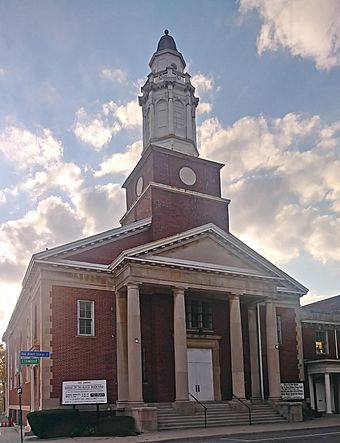Shrine of the Black Madonna facts for kids
Quick facts for kids |
|
|
Shrine of the Black Madonna of the Pan African Orthodox Christian Church
|
|

Front of church
|
|
| Location | 7625 Linwood St. Detroit, Michigan |
|---|---|
| Built | 1925 |
| Architect | George D. Mason |
| Architectural style | Colonial |
| MPS | The Civil Rights Movement and the African American Experience in 20th Century Detroit MPS |
| NRHP reference No. | 100006132 |
| Added to NRHP | February 5, 2021 |
The Shrine of the Black Madonna is a special church building in Detroit, Michigan. It's located at 7625 Linwood Street. This church is important because of its link to Rev. Albert B. Cleage Jr., a key leader in the African American civil rights movement. Many important civil rights events happened here in the 1900s. Because of its history, the building was added to the National Register of Historic Places in 2021.
Contents
The Church's Early Days
The church building we see today has a long history. Around 1915, a group called Pilgrim Congregational Church built a smaller church nearby. In 1925, they hired a famous architect named George D. Mason. He designed the brick building that stands now. It was finished in 1926. A few years later, their first wooden church burned down. They replaced it with a church hall, which was completed in 1930.
How the Shrine of the Black Madonna Began
By the late 1950s, the church group, then called Brewster-Pilgrim Congregational Church, started to get smaller. Many people were moving out of the city. In 1957, Reverend Albert B. Cleage Jr. bought the building for his church, Central Congregational Church.
A Center for Civil Rights
The church quickly became a very important place for the civil rights movement in Detroit. Reverend Cleage was involved in almost every civil rights action in the city. In 1963, he helped organize the Detroit Walk to Freedom. This huge event brought together 125,000 or more people. As the 1960s went on, Cleage continued his work for civil rights. He also started to focus more on Black Nationalist ideas. This meant he believed in Black people having their own power and pride.
The Black Madonna Mural
In 1967, Reverend Cleage asked a local Black artist, Glanton Dowdell, to paint a special mural. This mural showed a Black Madonna. It replaced an old stained-glass window that showed Pilgrims. The new mural was shown on Easter Sunday. It caused some people in the church to disagree. Some members who didn't agree with Cleage's Black Nationalist views left the church.
However, the Detroit rebellion of 1967 made Cleage even more active. After this, he renamed his church after the Black Madonna mural.
Growing the Church's Mission
Reverend Cleage was a key leader in Detroit's civil rights community throughout the 1960s and 1970s. He also started to focus on growing the church and on education. He opened new Shrine locations in Detroit and in other states. These included Atlanta, Georgia and Houston, Texas. Reverend Cleage passed away in 2000. However, the church continues its work today with new leaders.
What the Church Looks Like
The church building is a two-story, rectangular building. It is made from red bricks with stone decorations. The roof slopes down from the front and has asphalt shingles. A bell tower sits in the middle of the front of the church.
A large, two-story porch with columns runs across the front. It has a triangular top part. Under this porch, there is a section that sticks out. It has two entry doors side-by-side. Above these doors is a window with three parts. On either side of the entry, there are narrow, tall windows on the first floor. The second floor also has windows on both sides of the porch.
The nearby church hall is also a two-story, rectangular building. It is made of red bricks with stone trim. It has five sections, and each section has two windows on both floors. The middle three sections stick out a little. They are outlined with special corner stones. The church and the hall are connected by a small, one-story kitchen.
Images for kids



